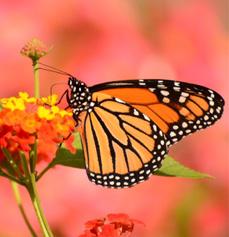“Escape from University to sit in a beautiful floral garden with butterflies”
The aim of ‘The Butterfly Effect’ is to serve as not only a social seating area for students and passers by but also as a home to the ever growing population of but











terflies in Brighton. Situated in a well used corner near the future main pedestrian bridge, the design is in the perfect location for commuters to stop for a coffee or for students to sit and study while feeling at one with nature. The Honeysuckle canopy creates the perfect habitat for butterflies to thrive and act as a home for the duration of their life. The simple to assemble self-supported temporary structure requires no glue or screws and instead relies on a slot together structure where each layer is stacked onto a pole system allowing the design to be quickly assembled or taken down. The shape of the design allows for multiple uses with the main use being aimed at a group of 2 or 3 people being able to sit in the booth like part of the design and have a more private interaction while also allowing for people to sit on the outer benches and corresponding stools (Made from the centre offcuts from the CNC cutting) providing more space and functionality for bigger groups or individual people to make the most out of the space.


Honey Suckle Plant

Plant Netting



Treated Plywood

Wild Flowers


-Specific wildflowers such as kidney vetch, knapweed and marjoram are known to attract butterflies and will be planted in the planters of our structure. Having a wide variety of plants will create a bright and colourful grouping of plants which will be overall more visually attractive to users and will also help to attract all types of butterfly in the area.
Honey suckles are a type of vine which is commonly used in butterfly gardens around the world, this is because it is the perfect home for caterpillars to transition into butter



flies, this is due to honeysuckle being a very tangled species of plant causing them to create balls and thick weaves around the plant net
ting creating the perfect home for butterflies while also being home to a huge floral display of primarily pink flowers which bloom on the vines.
The canopy structure will be created out of Plant netting allowing for the honey suckles to grow and weave into the netting giving them the perfect base to grow into. Plant netting lightweight and easy to erect onto the hook structure atop the poles. The plant netting will also allow for cocoons to have a perfect home while they develop and hatch entangles in the honeysuckle and plant netting canopy.
The Butterflies Most Commonly Found in Brighton

Treated Plywood is a cheap and easy to source material, Its also perfect to be used alongside a CNC cutter allowing for precise large shapes to be cut out of the sheets creating a more precise overall finish. Having the plywood treated ensures it will hold up to the weather for as long as the temporary structure is erected. Plywood is also not too heavy making it easier to be transported to site and meaning it will take less people to assemble.
Small Blue


The small blue is the smallest of all the UK’s butterflies. Adults are on the wing from May to August and can be seen feeding on common bird’sfoot-trefoil or horseshoe vetch on chalk grassland, but only where kidney vetch also grows - the sole foodplant of the caterpillars. Males set up territories in sheltered places and the females lay their eggs on the kidney vetch or commonly on honeysuckle; the emerging caterpillars feed on the flowerheads.
Marbled White

The marbled white is a distinctive, medium-sized, white butterfly, with black-chequered markings. Adults are on the wing in the summer, from June to August. Strong colonies can be found on warm, species-rich chalk and limestone grasslands, but woodland rides, railways cuttings and road verges are also frequented. The adults can often be seen feeding on purple flowers, such as field scabious, common knapweed and wild marjoram. The caterpillars feed on a variety of grasses, but red fescue is especially important.
CNC Cutting

The main structure will be constructed of CNC cut plywood and then layered together being supported by a series of 60mm poles around the structure. CNC cutting is a cheap and quick source of fabrica





-tion for wooden parts and will allow us to use large sheets of ply to cut our shapes with the offcuts being used as stools to accompany the main structure. The main benefit of using CNC cut ply is that is means every layer will be perfectly cut allowing the structure to fit together without any alterations made. CNC cutting is also very quick meaning the fabrication time for the entire structure would be estimated at around 20 hours.
The white-letter hairstreak is a small butterfly that breeds in elm trees in hedgerows, woodland rides and scrub. It can be hard to spot as it flutters around the treetops and vine covered surfac


es, but does come down to low
er levels to nectar on flowers like bramble. Adults are on the wing from June to August, and there is only one brood per year. Caterpillars are well camouflaged, looking like young buds and leaves.

